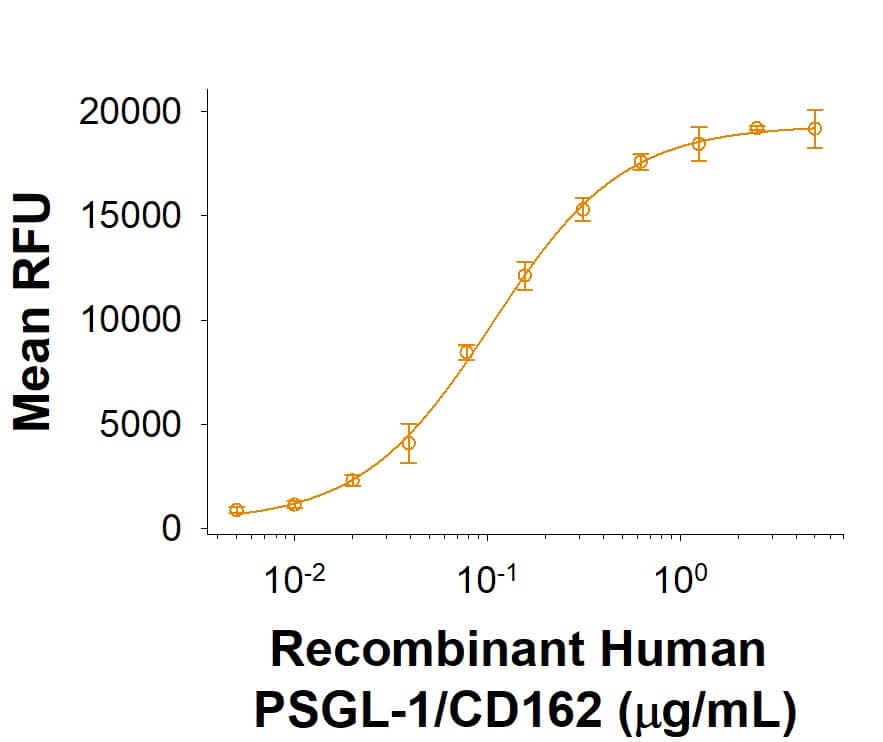Recombinant Human PSGL-1/CD162 Fc Chimera Protein, CF
R&D Systems, part of Bio-Techne | Catalog # 3345-PS

Key Product Details
Source
CHO
Accession #
Structure / Form
Disulfide-linked homodimer
Conjugate
Unconjugated
Applications
Bioactivity
Product Specifications
Source
Chinese Hamster Ovary cell line, CHO-derived human PSGL-1/CD162 protein
| Human PSGL-1 (Gln42-Val295) Accession # AAC50061 |
IEGRMD | Human IgG1 (Pro100-Lys330) |
| N-terminus | C-terminus |
Purity
>95%, by SDS-PAGE visualized with Silver Staining and quantitative densitometry by Coomassie® Blue Staining.
Endotoxin Level
<0.10 EU per 1 μg of the protein by the LAL method.
N-terminal Sequence Analysis
Gln42
Predicted Molecular Mass
52.6 kDa (monomer)
SDS-PAGE
100-150 kDa, reducing conditions
Activity
Measured by the ability of the immobilized protein to support the adhesion of CHO Chinese hamster ovary cells transfected with P-Selectin.
The ED50 for this effect is 0.04-0.32 µg/mL.
The ED50 for this effect is 0.04-0.32 µg/mL.
Reviewed Applications
Read 1 review rated 4 using 3345-PS in the following applications:
Scientific Data Images for Recombinant Human PSGL-1/CD162 Fc Chimera Protein, CF
Recombinant Human PSGL-1/CD162 Fc Chimera Protein Bioactivity
Recombinant Human PSGL-1/CD162 Fc Chimera (Catalog # 3345-PS) supports the adhesion of CHO Chinese hamster ovary cells transfected with P-Selectin. The ED50 for this effect is 0.04-0.32 μg/mL.Formulation, Preparation and Storage
3345-PS
| Formulation | Lyophilized from a 0.2 μm filtered solution in Tris and NaCl. |
| Reconstitution |
Reconstitute at 100 μg/mL in sterile PBS.
|
| Shipping | The product is shipped at ambient temperature. Upon receipt, store it immediately at the temperature recommended below. |
| Stability & Storage | Use a manual defrost freezer and avoid repeated freeze-thaw cycles.
|
Background: PSGL-1/CD162
References
- Yang, J. et al. (1999) Thromb. Haemost. 81:1.
- Sako, D. et al. (1993) Cell 75:1179.
- Carlow, D.A. et al. (2009) Immunol. Rev. 230:75.
- Zarbock, A. et al. (2011) Blood 278:37.
- Bernimoulin, M.P. et al. (2003) J. Biol. Chem. 278:37.
- Sako, D. et al. (1995) Cell 83:323.
- Xia, L. et al. (2003) Blood 101:552.
- Gardiner, E.E. et al. (2001) Blood 98:1440.
- Lozano, M.L. et al. (2001) Br. J. Haematol. 115:969.
- Veerman, K.M. et al. (2007) Nat. Immunol. 8:532.
- Hirata, T. et al. (2004) J. Biol. Chem. 279:51775.
- del Conde, I. et al. (2005) Blood 106:1604.
- Thomas, G.M. et al. (2009) J Exp. Med. 206:1913.
Long Name
P-Selectin Glycoprotein Ligand 1
Alternate Names
CD162, PSGL1, SELPLG
Gene Symbol
SELPLG
UniProt
Additional PSGL-1/CD162 Products
Product Documents for Recombinant Human PSGL-1/CD162 Fc Chimera Protein, CF
Product Specific Notices for Recombinant Human PSGL-1/CD162 Fc Chimera Protein, CF
For research use only
